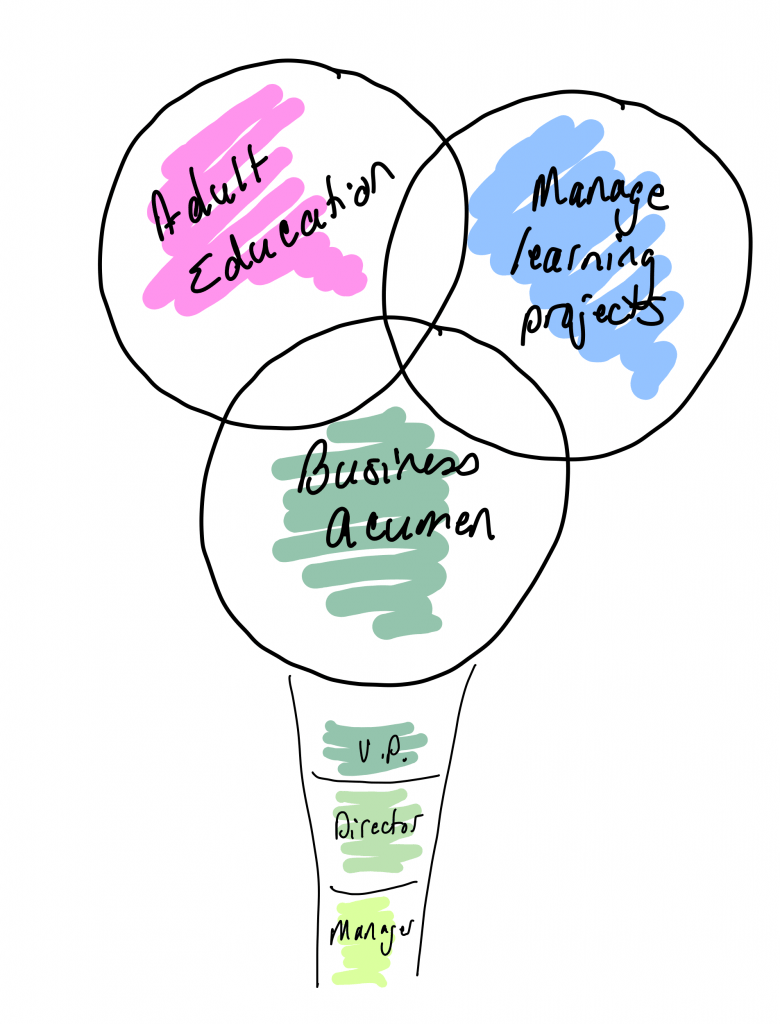I’ve been meeting with folks over the last few months having coffees and breakfasts, which has been fabulous. [I love back I person!] We’ve been discussing a model I’ve been working on that is the basis for a program and perhaps my next book. The model identifies the skills leaders need to manage the training function successfully.
I thought I’d use this newsletter to introduce my thinking and to say thank you to all the folks who so far have generously provided their perspective, feedback and time.
What skills does a manager need to lead the training function?
There are three critical areas managers need to lead the training function effectively. I’m calling it my ‘ice cream’ model.
- Background in adult education
- The ability to manage learning projects
- Business acumen
Adult Education
If you’ve grown up in the learning and development profession, having a background in adult education may seem so obvious that it doesn’t warrant including.
What I’ve observed, however, is that often the person leading the training function has come from the business. They know the business and have deep content expertise. They don’t have an adult education background, so it can be challenging for these managers to lead their teams and communicate the value of learning to the organization.
These managers don’t need to become learning and development experts. They just need a foundation in adult learning – the principles, how to write objectives, how to engage adult learners – so they can effectively lead their teams.
Managing learning projects
The second area where managers need expertise is project management. They don’t need to become project managers but need project management skills to lead their teams and liaise with their client groups. Essential project management skills include the ability to scope project resources, timelines and quality; contract with their client group; negotiate and clarify roles and expectations; create a project plan, including dependencies. Once the project is underway, they need skills to manage scope creep and provide ongoing communication in their role as a liaison.
Business acumen
The third area managers need to effectively lead the training function is business acumen. This is especially important if the manager started their career as an instructional designer, facilitator or trainer. To effectively serve your organization, it’s critical to understand the language your clients speak.
In one of my coffee conversations, a woman said that she tells her team,
“Don’t be learning snobs.”
I love that phrase! So often, we can get caught up in our learning and development expertise that we talk jargon to our clients. And while we’re talking “learning speak” they’re talking “business speak.” We’re talking about learning objectives and delivery channels. We are focused on the ratio of design time to finished learning time. They’re talking about budgets, time to market, minimum viable products and return on investment.
We need to speak the same language to understand the performance need and recommend the best solution – training or otherwise. We need to speak the business language so we can instill trust in the clients we support.
When we measure the effectiveness of training programs, we use language and metrics the business understands and cares about.

I call this an ice cream model because the level of business acumen varies at different levels in the organization. A manager’s need will be narrower because their scope of control is smaller.
As you move into a director role and a VP role, your depth of understanding deepens as your scope of control broadens.
People leadership
I haven’t included people leadership in this model. It is an essential skill and universal for all managers. There are many books and models for learning how to communicate, delegate and inspire team members. This model is specific for managers in a learning function. I’ve stripped out people leadership not because its unimportant but because its so important, and managers can learn all these skills through other channels.
When one skill set is missing
I’m curious to hear what it looks like when these skills are missing. What’s the manager’s experience – what’s the impact on the team and the organization?
- What does it look like when the manager doesn’t have a background in adult education?
- If the manager struggles to manage learning projects effectively, what does that look like?
- And finally, what does it look like if the manager lacks business acumen skills?
When managers understand how adults learn, can manage projects, and speak the same language as their clients, their team designs programs that meet the business’ and participants’ needs. Implementation is smoother, and managers are viewed as a valued partner in their organization.
In case you missed it
I’ve shared some additional posts online. I’ve been exploring training from an organization’s perspective and learning from an employee’s perspective. Here they are in case you missed them.
- L&D speaking the language of business – (video link)
- Motivation in Mexico – (video link)
- Learning managers as Learning Business Partners – (video link)

Training that Clicks book – I’ve written a book about virtual training. You can find out more at www.trainingthatclicks.ca
I also posted about my book-writing journey on LinkedIn. Follow this hashtag #bookbyhannah to follow along.



